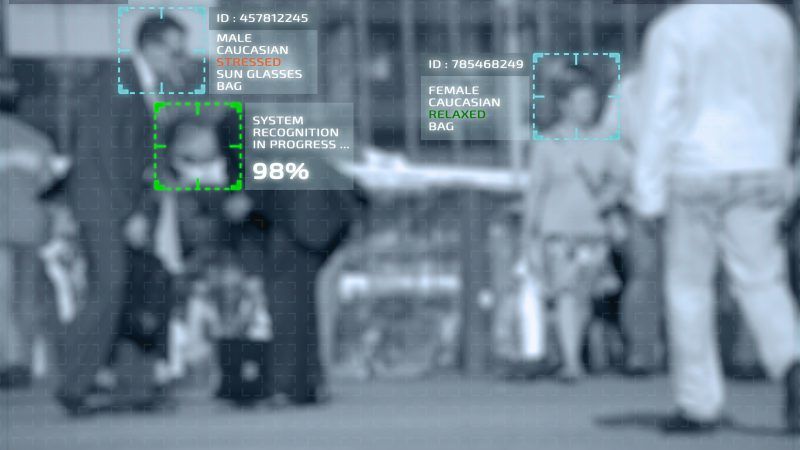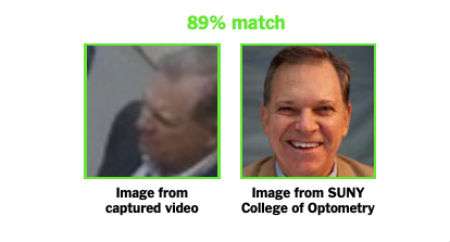The New York Times Built a Functioning Private Facial Recognition System
Should you be worried?

China's Skynet and Sharp Eyes projects aim to comprehensively surveil China's 1.4 billion people by 2020 through a network of 626 million video cameras stationed in public spaces monitored using facial recognition technologies optimized via artificial intelligence. These vast video surveillance systems will help enforce the Chinese government's social credit system that awards points to citizens who behave and docks those who commit crimes, fail to pay bills, or criticize the communist regime. Folks who get put on the government's "List of Untrustworthy Persons" due to their low scores are forbidden from purchasing such items as high-speed rail and air tickets or hotel rooms, among other punishments. Five million people have been barred from high-speed trains and 17 million from flights under the scheme, according to Time magazine.
Although it is hard to gauge real public sentiment in authoritarian China, there is some evidence that many Chinese citizens feel safer knowing that Big Brother is watching over them. On the other hand, The New York Times reports in an article published as part of its superb Privacy Project that the Chinese government has built out a video surveillance system designed to ethnically profile and track millions of its restive Uighur citizens. This is possible because Central Asian Uighurs in general look somewhat differently from China's majority Han population.
"The facial recognition technology, which is integrated into China's rapidly expanding networks of surveillance cameras, looks exclusively for Uighurs based on their appearance and keeps records of their comings and goings for search and review," reports the Times. "The practice makes China a pioneer in applying next-generation technology to watch its people, potentially ushering in a new era of automated racism."
Clare Garvie, an associate at the Center on Privacy and Technology at Georgetown Law told the Times,"If you make a technology that can classify people by an ethnicity, someone will use it to repress that ethnicity."
To see how effective facial recognition video surveillance might be in the United States, the Times ran a test using off-the-shelf Amazon facial recognition technology to filter images captured from video cameras located in Bryant Park behind the New York Public Library's main branch. The Times ran the Bryant Park images through a database it built using public photos of people who work in the area. The result:
Our system detected 2,750 faces from a nine-hour period (not necessarily unique people, since a person could be captured in multiple frames). It returned several possible identifications, including one frame matched to a head shot of Richard Madonna, a professor at the SUNY College of Optometry, with an 89 percent similarity score. The total cost: about $60.

As government and private face databases expand and real time video detection accuracy improves, the cost of tracking us will fall ever lower. The Times notes that New York city police have access to 9,000 camera feeds in lower Manhattan alone. Jennifer Lynch, surveillance litigation director at the Electronic Frontier Foundation, told the Times that because of how quickly the technology has advanced, she would now support a wholesale ban on government use of facial recognition.
In the Times' article detailing how the Chinese government uses facial recognition to monitor the Uighurs, MIT artificial intelligence researcher Jonathan Frankle warned, "I don't think it's overblown to treat this as an existential threat to democracy. Once a country adopts a model in this heavy authoritarian mode, it's using data to enforce thought and rules in a much more deep-seated fashion than might have been achievable 70 years ago in the Soviet Union. To that extent, this is an urgent crisis we are slowly sleepwalking our way into."
Yes it is.
Editor's Note: As of February 29, 2024, commenting privileges on reason.com posts are limited to Reason Plus subscribers. Past commenters are grandfathered in for a temporary period. Subscribe here to preserve your ability to comment. Your Reason Plus subscription also gives you an ad-free version of reason.com, along with full access to the digital edition and archives of Reason magazine. We request that comments be civil and on-topic. We do not moderate or assume any responsibility for comments, which are owned by the readers who post them. Comments do not represent the views of reason.com or Reason Foundation. We reserve the right to delete any comment and ban commenters for any reason at any time. Comments may only be edited within 5 minutes of posting. Report abuses.
Please to post comments




I wear a fake nose and moostachio so the software gets confused.
I'm not worried about the New York Times, it's a private fake news organization run by progTard sore losers who are still crying like babies because Hillary Clinton lost.
Can the facial recognition system identify a boot stomping on the face?
Right boot or left boot? With the NYT, it matters.
*slow clap*
Only if you are doing something the ruling supreme leaders dislike.
I read the linked New York Times article and while it's heavy on implication, citing what companies are behind the technology, who wants the technology and how it's being used, it's very light on details regarding how accurate and useful it is. And in technology articles, this is always the thinnest thread: does it actually work?
Side note: There's research that shows a hat with IR leds under the bill can confuse the living tar out of facial recognition technology.
It's nice to see Bailey reviewing an old video game like Beholder.
Wait a minute...you mean this shit's real????
I think China watched Black Mirror and said "hey, that's a great idea!"
Their social credit score scheme is pretty much note-for-note out of the dystopian model presented in the Sci-Fi show.
Wear a hat. Confuses all current facial recognition technology.
Even a MAGA hat?
Not so much, no.
Hat and sunglasses might do a bit of obscuring. But if you get a clear shot, it'll find you. The only thing affected is the false positive rate.
But if you have continuity of data sources, computers could trivially resolve it down to exactly one person for every face... with the ubiquity of imaging, all they have to do is pick you up in one known location and then they can extrapolate your path and pick you up on every camera you pass.
This isn't far-flung sci-fi. This is available now, only pending the actual building of the interconnected system.
Just wait for the NYT's facial recognition software mis-genders an SJW activist or Hillary Clinton. The resulting lawsuit should be magnificent.
Or demands hijabs be removed.
[…] [ April 23, 2019 ] Reason – The New York Times Built a Functioning Private Facial Recognit… […]
Seriously, though, this shit needs to be outlawed in the USA, now, before law enforcement gets hooked and claims they need it. They already ignore dangerous drivers and just rely on license plate readers.
hew boy
DHS has your face on record
So JetBlue scans your face, uploads the image to Customs and Border Patrol, where it is compared to their database of faces. So, the Department of Homeland Security has a database of everyone's face.
Remember when DHS was created and everyone said the name sounded Orwellian?
The REAL ID program requires the states to capture facial-recognition data and transmit it to the federal government. As far as I am aware, every state has now signed on to the program, so if you have a REAL ID-compliant identification card or driver's license, you're already in the database. Congratulations, and welcome to Black Mirror: Live!
We're finally getting to the point where lots of new technology is having more downsides than upsides... 1984 is going to look like a paradise if we don't manage to get government going in a good direction going forward.
government cannot be put on the correct path, It is by nature, the surrender of basic rights and responsibility of many humans to consolidate it into the hands of very few, and obviously the most corrupt.
this is by design not by error
[…] Reason: The New York Times built a functioning private facial recognition system […]
[…] a professor that teaches nearby. The team was shocked at how cheap it was to do that good of a job. Link Amazon’s warehouses are largely so efficient due to extreme monitoring of packing staff. […]
[…] By bubmag April 23, 2019 No Comments […]